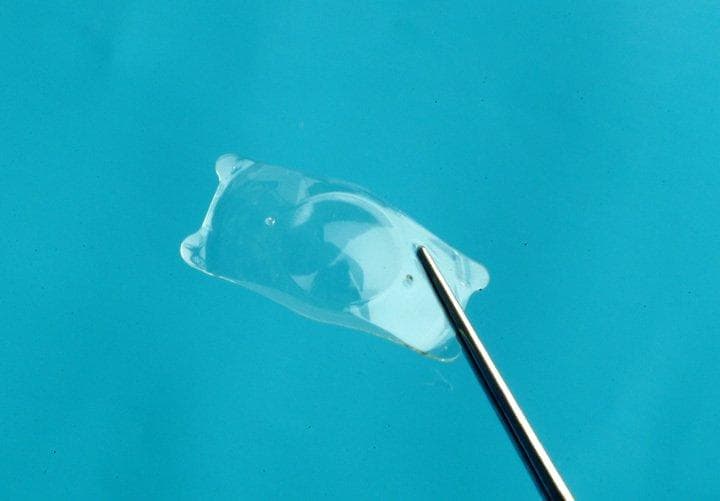An Evolution in Visual Freedom. Meet the EVO ICL!

An Evolution in Visual Freedom TM
Today, there are quite a few options for vision correction, with LASIK surgeries being one of the more popular procedures offered. Many of these procedures promise improved vision, but few can match the quality and feature set of top LASIK alternative, EVO ICL (EVO).
What is EVO ICL?
Some people incorrectly refer to the ICL in EVO ICL as “Implantable Contact Lens,” but the correct term is “Implantable Collamer Lens.” Collamer is a technologically advanced lens material created by EVO ICL’s parent company, STAAR Surgical.
Thanks to the collagen base in Collamer, EVO ICL’s intraocular lenses are biocompatible with your body and work in harmony with your natural eye, in stark contrast to the more invasive LASIK procedure. Some of Collamer’s advantages include its anti-reflective properties and UV protection. If you’re looking for a lens that can help improve your vision for a lifetime, EVO ICL is the right choice.

A Simple Procedure
EVO ICL only takes 20-30 minutes in an outpatient setting. Before the procedure, you’ll receive topical anesthetic drops to reduce discomfort. Once the drops have taken effect, your doctor will create a small opening for EVO ICL lens insertion. The lens is folded and loaded in a small cartridge. As the lens is injected, it gently unfolds in your eye. The best part? Improvement in vision generally follows very quickly.
Good Candidates
Nearsighted (myopic) patients between 21 and 45 can be excellent candidates for EVO ICL. Further, if you suffer from thin corneas, dry eyes and either low or extreme nearsightedness, EVO ICL is worth a serious look.

1,000,000+ lenses and growing
To date, hundreds of thousands of patients have experienced the life-changing power of EVO ICL. Everyone from high-performing athletes to celebrities and elite military personnel have experienced visual freedom with EVO ICL. Imagine what EVO ICL can do for you!
Important Safety Information
The EVO Visian ICL Lens is intended for the correction of moderate to high nearsightedness. EVO Visian ICL and EVO Visian TICL surgery is intended to safely and effectively correct nearsightedness between -3.0 D to -15.0 D, the reduction in nearsightedness up to -20.0 D and treatment of astigmatism from 1.0 D to 4.0 D. If you have nearsightedness within these ranges, EVO Visian ICL surgery may improve your distance vision without eyeglasses or contact lenses. Because the EVO Visian ICL corrects for distance vision, it does not eliminate the need for reading glasses, you may require them at some point, even if you have never worn them before.
Implantation of the EVO Visian ICL is a surgical procedure, and as such, carries potentially serious risks. Please discuss the risks with your eye care professional. Complications, although rare, may include need for additional surgical procedures, inflammation, loss of cells from the back surface of the cornea, increase in eye pressure, and cataracts.
You should NOT have EVO Visian ICL surgery if:
- Your doctor determines that the shape of your eye is not an appropriate fit for the EVO Visian ICL
- You are pregnant or nursing
- You have moderate to severe damage to the optic nerve caused by increased pressure (glaucoma)
- You do not meet the minimum endothelial cell density for your age at the time of implantation as determined by your eye doctor
- Your vision is not stable as determined by your eye doctor
Before considering EVO Visian ICL surgery you should have a complete eye examination and talk with your eye care professional about EVO Visian ICL surgery, especially the potential benefits, risks, and complications. You should discuss the time needed for healing after surgery. For additional information with potential benefits, risks and complications please visit DiscoverICL.com.
Select Your Region
Latin America
References
1. Packer M. The Implantable Collamer Lens with a central port: review of the literature. Clin Ophthalmol. 2018;12:2427-2438.
2. Martínez-Plaza E, López-Miguel A, López-de la Rosa A, et al. Effect of the EVO+ Visian Phakic Implantable Collamer Lens on Visual Performance and Quality of Vision and Life, Am J Ophthalmol 2021;226:117-125.
3. Packer M. Evaluation of the EVO/EVO+ Sphere and Toric Visian ICL: Six month results from the United States Food and Drug Administration clinical trial. Clinical Ophthalmology. 2022;16:1541-53.
4. Parkhurst GD. A prospective comparison of phakic collamer lenses and wavefront-optimized laser-assisted in situ keratomileusis for correction of myopia. Clin Ophthalmol. 2016;10:1209-1215.
5. Zhang H, Deng Y, Ma K, Yin H, Tang J. Analysis on the changes of objective indicators of dry eye after implantable collamer lens (ICL) implantation surgery. Graefes Arch Clin Exp Ophthalmol. 2024 Jul; 262(7):2321-2328
6. Shoja, MR. Besharati, MR. Dry eye after LASIK for myopia: Incidence and risk factors. Eur J of Ophthalmol. 2007; 17(1): pp. 1-6.
7. Lee, Jae Bum et al. Comparison of tear secretion and tear film instability after photorefractive keratectomy and laser in situ keratomileusis. J Cataract Refract Surg., Volume 26 , Issue 9 , 1326 - 1331.
8. Parkhurst, G. Psolka, M. Kezirian, G. Phakic intraocular lens implantantion in United States military warfighters: A retrospective analysis of early clinical outcomes of the Visian ICL. J Refract Surg. 2011;27(7):473-481.
Feeling unsure?
We get it. Decisions like this take time to consider and research. We can help guide your decision with information that's the most relevant to you.
Do you currently wear glasses or contacts?